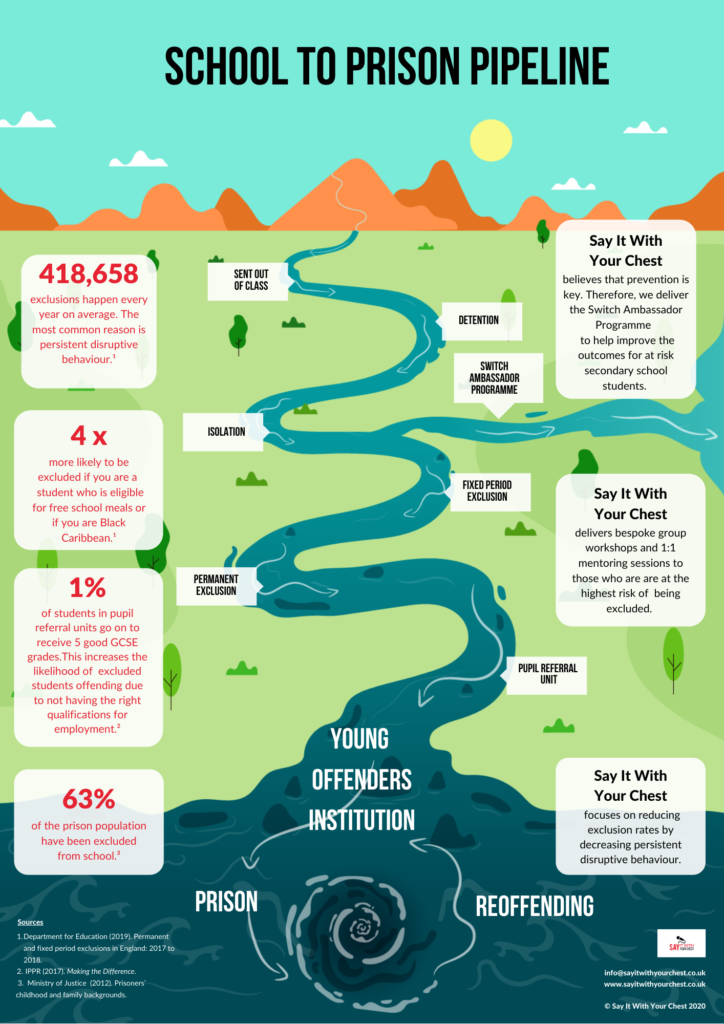In 2020 we created the School to Prison Pipeline. In one image, we show the risks to young people getting sucked into a life in which education gets harder to access. A life that too often leads to crime, prison and reoffending. It was the reason Sabrina Jones founded Say it With Your Chest. The aim is to help young people find a way out through one-to-one mentoring and group workshops (see more about the Switch Ambassador Programme).
But should it be left to not-for-profit organisations like ours to stem the tide? With all the resources from schools, alternative providers (AP), social services, and the police (to name only some of those involved) does the system really do its job? And what job is it supposed to be doing?

The School to Prison Pipeline charts the route from school behaviour to a potential life of reoffending
The stats behind the pipeline
Let’s start with some stats. Between 2015 and 2020 an average of just over 7000 students an academic year were subject to permanent exclusion from schools in England, meaning they won’t return to that school [1]. That’s a lot of young people left looking for a new education. That usually means a pupil referral unit (PRU). According to the Local Government Association just over 12,000 pupils in England where in PRUs during the academic year 2020/21 [2]. But it’s likely that the pandemic reduced exclusions and the number in these units is usually closer to 15,000.
What does this mean for those young people caught up in that pipeline? A study, carried out for the Department of Education in October 2018 [3] found that the majority of schools took active steps to identify pupils thought to be at risk, but also found that ‘support strategies to prevent exclusion tended to focus on addressing poor behaviour rather than the root causes of this’. According to the report those providing additional services for such students (such as PRUs), as well as the pupils themselves and their parents suggested mainstream schools have ‘limited capability’ to spot and fully support students with learning difficulties, special needs or mental health problems. While schools found getting access to external support ‘difficult and/or slow’ with ‘demand outstripping supply’.
The result
The result for some is clear. Compared to special and mainstream settings young people leaving AP do much worse. According to the Department of Education, in 2015/16 more than one in three young people aged 16 leaving AP did not go on to further education, employment or training, compared to around one in twenty leaving special and mainstream schools [4]. When you add the fact that 63% of people in prison have been excluded from school at some point [5], you start to see a clear line between young people who struggle with their behaviour at school and prison.
The big question
So, is there a better way? And if so, how do we get there? In a series of blogs, we want to look at the pipeline from the various different perspectives. What it means not just for young people but for all others involved. And in doing so hope to start a conversation on how we, as a society, find that better way.
References
[1] Permanent exclusions and suspensions in England – Department of Education https://explore-education-statistics.service.gov.uk/find-statistics/permanent-and-fixed-period-exclusions-in-england/2019-20#dataBlock-6efcb4b3-0023-4a8e-fed6-08d94c21d8b6-tables
[2] Number of pupils in pupil referral units (headcount) in England – Local Government Association https://lginform.local.gov.uk/reports/lgastandard?mod-metric=2208&mod-area=E92000001&mod-group=AllRegions_England&mod-type=namedComparisonGroup
[3] Investigative research into alternative provision – Department of Education, October 2018 Investigative research into alternative provision – GOV.UK (www.gov.uk)
[4] Creating opportunity for all: Our vision for alternative provision – Department of Education, March 2018 Creating opportunity for all (publishing.service.gov.uk)
[5] Prisoners’ childhood and family backgrounds – Ministry of Justice, March 2012 https://assets.publishing.service.gov.uk/government/uploads/system/uploads/attachment_data/file/278837/prisoners-childhood-family-backgrounds.pdf